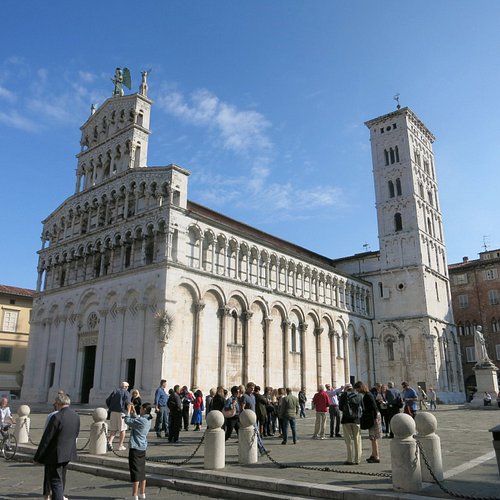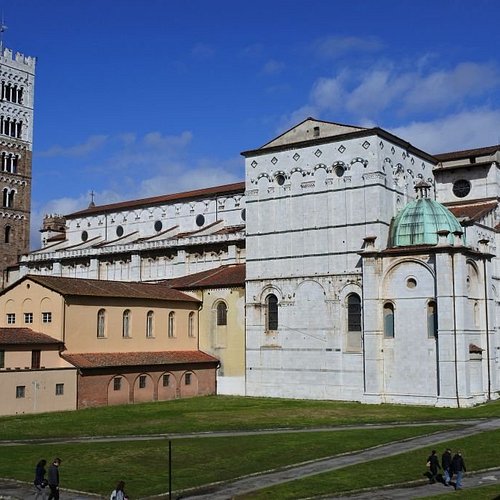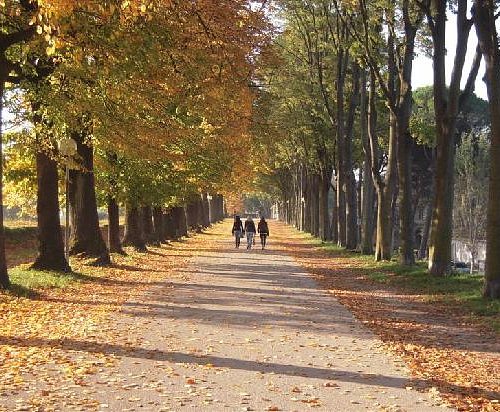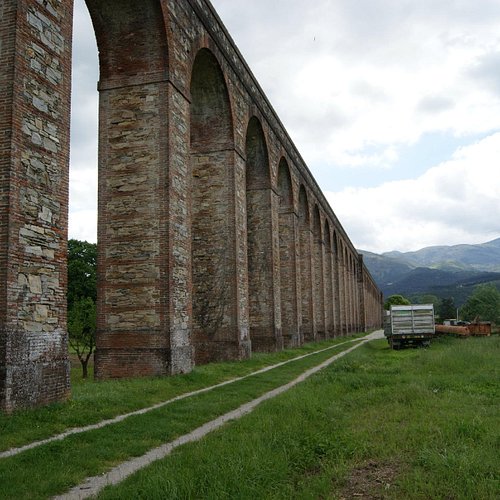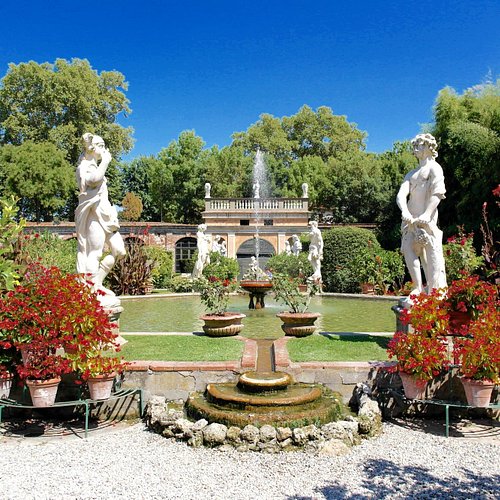The 10 Best Historic Sites in Lucca, Tuscany
Lucca's array of wonderfully intact historical sites makes it a must-see stop on any Tuscan itinerary. The medieval city walls still stand—you can hike or bike on top of them. Also visit the Duomo di San Martino and the Roman amphitheater.
Restaurants in Lucca
1. Puccini Museum - Casa Natale
Overall Ratings
4.5 based on 637 reviews
The museum is located in a flat on the second floor of an ancient building in the heart of Lucca, where Giacomo Puccini was born on December 22, 1858. In this house the composer spent the years of his childhood and first youth. The birth home was transformed into a museum in 1979 and carefully restored in 2011: today it looks like when young Giacomo lived there. The museum preserves Puccini’s Steinway & Sons piano on which he composed Turandot, autograph scores of youthful compositions, letters, photographs, precious drafts, such as the “libretti” of Tosca, La fanciulla del West and an extraordinary musical sketch of La bohème. Noteworthy the costume of Turandot worn by Maria Jeritza at the Metropolitan Opera House of New York in 1926. The birth home is a central element of Puccini Museum, the articulate museum complex that, following a journey along the footprints left by the great composer, rediscovers his personality, his passions, his genius.
Reviewed By mcr1018 - Phoenix, United States
I can take opera or leave it (although some of the music is well known outside the opera house), but when in Lucca, this museum is fascinating, We bought our tickets at the office & bookshop on the plaza (Piazza Cittadella; where the Puccini statue is), and the museum is well-marked on a street off of it. We walked up a long flight of stairs to the museum (there is a lift, but we read later that it has to be booked to use "at least 2 days before the visit" at the ticket office. We were welcomed by a very knowledgeable staff person who would occasionally stop in a room to tell us about something special (it wasn't crowded). We wandered around the rooms, following the map. Many items of the era and Puccini's life and creative works were displayed. Of particular pride was the Steinway piano and autographed scores and markings of modifications or interpretations. The 1926 costume of Turandot from the NY Metropolitan Opera amazing even to a opera neutral such as me. We saw the upper room (garret?) where he composed and could just see the "angel" statue over the rooftops from the Cathedrale San Michele--an inspiration. I've been to many homes of significant authors and composers, sometimes disappointed and sometimes inspired myself; this one was worth the time and entrance fee. [The map/program says no pictures or video recording, but the staff person said it was okay.]
2. Lucca's Duomo (Cattedrale di San Martino)
Overall Ratings
4.5 based on 2,516 reviews
Reviewed By LePatioDordogne - France, null
We paid €9 each for the ticket which allowed you to climb to the top of the bell tower (you need a good head for heights), into the spectacular cathedral and into the museum. We thought it was great value for money, the views were amazing, the stained glass windows and paintings were beautiful and the museum was great. We highly recommend this.
3. Le mura di Lucca
Overall Ratings
4.5 based on 9,271 reviews
Reviewed By Amethyst627 - York, United Kingdom
Whether you walk or cycle around the walls you will get a real feel for the scale and attractions of Lucca. Some of the underground areas are also worth dropping down for a view.
4. Acquedotto del Nottolini
Overall Ratings
4.5 based on 201 reviews
Reviewed By 1Yvonne1
Duchess Maria Luisa of Bourbon commissioned the project to build the aqueduct in 1823; it was designed by architect Lorenzo Nottolini. The structure begins just behind the train station, at the Cistern of San Concordio, once used to carry water from the mountains into the city and contained 400 arches made from stone stretching for 3.5kms. Today the aqueduct stands in its entirety. I followed the dirt path beside the aqueduct completely captivated by the peaceful surroundings. The full length from the Temple cistern to its end at the Parco dell’Acquedotto takes about 20mins. Words cannot express how truly magnificent this feat of engineering is, just stunning. The path is also a popular cycling track. After every 17 arch there was a decorative buttress constructed to take care of the strength of the structure. However, during the 20th century, 6 arches were removed, and water supply was interrupted for the passage of A11 Motorway that connects Lucca and Capannori. The footbridge over the autostrada felt a bit dodgy, the low railings allowing gusts of wind as large lorries rolled underneath. I was very pleased to reach the other side in one piece. From the overpass I followed the aqueduct a further 2kms where Nottolini’s spectacular arches ended near the town of Guamo. The cistern at Guamo Whence was the first tank that supplied water to the city. It is also where we see the first arch of the aqueduct. The water of the aqueduct was drawn from several springs on the northern slope of Mount of Vorno, then passed through a number of layers of gravel and stone, purifying it before arriving to the temple-cistern of Guamo. From there the water was channelled inside the conduit that you can still admire today. From this point on, the arches are interrupted and the underground conduits begin. The presence of the aqueduct is still easily identifiable thanks to the numerous brick filtering wells (the ancestors of modern manholes) and other cisterns. Following the direction of the underground aqueduct, I reached an enchanting spot, the place where the waters coming from the Serra Vespaiata pass under a small bridge. The architectural innovation of Nottolini is evident in construction of the manufactured waterways that cut gentle curves through the hills between San Quirico and Vorno. From here the waterways give way to forest, then to olive groves and ancient stone houses. Follow the path up through the forest for another 2.3km to the road. From here turn right, 100m down the road is the panoramic point of Gallonzora where you can enjoy views of the Lucca plain to the Apuan Alps. Winding my way down the road the sun is shining, olive trees are bearing fruit, poppies are in bloom. On the way to Lucca you will pass through the villages of Vorno and Guamo. There are a couple of nice churches to check out and one or two cafes worth stopping at.
5. Santuario di Santa Gemma Galgani
Overall Ratings
4.5 based on 33 reviews
Reviewed By RichardBoise - Boise, United States
We visited in May and were pleased to see that a new museum has now opened, and it complements and supplements the church quite well. The museum focuses on the life of Santa Gemma and contains many genuine relics of her life, some of which are quite touching. Her fingerless gloves, for example, were worn to cover the marks of the stigmata, and the last bits of clothing she wore show the stains of her death from tuberculosis. In addition, the museum has a first-class collection of relics of other saints. Truly a magnificent array of mementos tastefully arranged in several glass cabinets. The Santuario is just outside the walls and is a short walk from the Porta Elisa.
6. Castello di Nozzano
Overall Ratings
4.5 based on 12 reviews
7. Ex Ospedale Psichiatrico di Maggiano
8. Palazzo Pfanner
Overall Ratings
4.0 based on 753 reviews
A visit to this 17th-century villa with its magnificent gardens is well worthwhile.
Reviewed By TravelerMikePlano
The palazzo is beautiful, from the gardens to the interior design. The history of the doctor who lived here was amazing. The most interesting items on display were his medical instruments as well as numerous books he had written or collected on medica issues and anatomy.
9. Villa Grabau
Overall Ratings
4.0 based on 103 reviews
Only 7 kilometers from the city centre of Lucca,the Villa Grabau offers a lovely,romantic environment: the wonderful English Garden is a special example of botanical garden and keeps trees from all over the world;absolutely do not miss it in autumn....the colours are the most beautiful you can find in the area;and in summertime it is the perfect place to spend a lovely time.The Limonaia is a real jewel, perfectly preserved from 1640; the Italian Garden will appear to you as if coming suddenly from the past,with its valuable collection of lemon trees in rich old terracotta pots;the elegant groundfloor of the Villa is totally furnished and the rooms show amazing frescoes.
10. Domus Romana
Overall Ratings
4.0 based on 144 reviews
Reviewed By hollyhQ6413GF - Richmond, United States
We had a terrific University Intern give us our private tour. We arrived shortly after the museum opened. She truly loved her home town, Lucca, and felt honored to be an Intern. She deserves an A for her semester work. Her conversations & education about how to understand archeology was terrific. We visited four museums after her one hour tour. What she taught us made us understand so much more about Ancient Italy, throughout our next two weeks.

